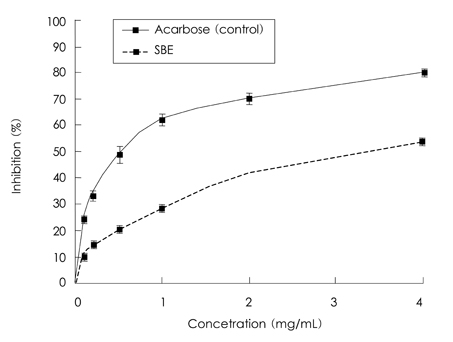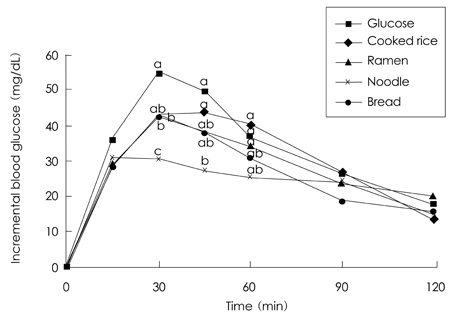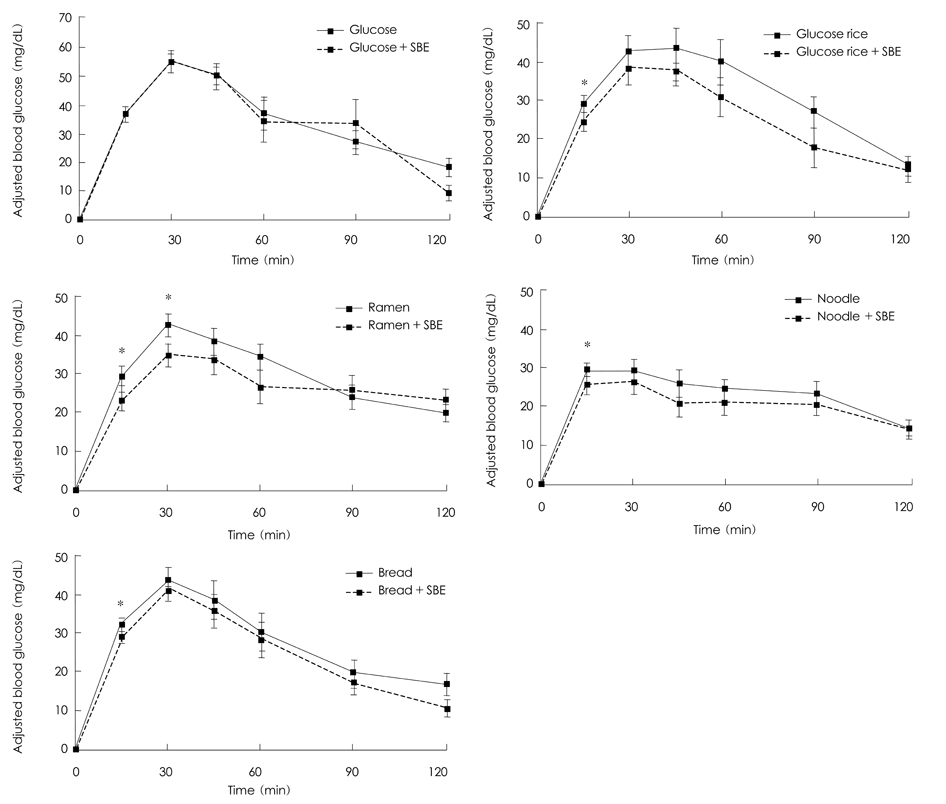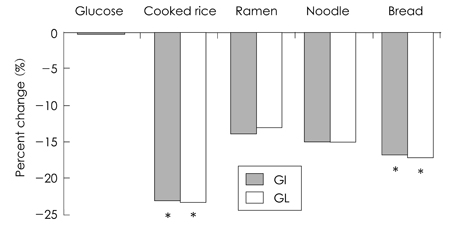Korean J Nutr.
2010 Jun;43(3):215-223. 10.4163/kjn.2010.43.3.215.
Effects of Sasa Borealis Leaf Extract on the Glucose Tolerance of Major Foods for Carbohydrate
- Affiliations
-
- 1Department of Food and Nutrition, Chonnam National University, Gwangju 500-757, Korea. limhs@chonnam.ac.kr
- 2Human Ecology Research Institute, Chonnam National University, Gwangju 500-757, Korea.
- KMID: 2268011
- DOI: http://doi.org/10.4163/kjn.2010.43.3.215
Abstract
- Sasa borealis leaf has been known to have anti-diabetic properties. In this study, we tried to evaluate the effects of Sasa borealis leaf extract (SBE) on the inhibition of alpha-glucosidase activity and postprandial glycemic response following ingestion of four carbohydrate-rich foods; cooked rice, ramen (instant noodle), noodle, and bread. Fourteen healthy female adults consumed 50 g of glucose (control) or one of the four foods containing 50 g of available carbohydrate with or without 2,000 mg of SBE. The activity of alpha-glucosidase was inhibited dose-dependently by SBE. With SBE, blood glucose concentration at 15 min and the positive area under the curve (AUC) of postprandial glycemic response at 15 min and 30 min after consuming each of the four foods were reduced significantly. As the result, total positive AUC during 120 min was decreased in case of taking cooked rice or bread. Glycemic index and glycemic load of the four foods were declined from 13% to 23% with SBE. The results of this study suggest that SBE may be effective for postprandial glucose control by inhibiting alpha-glucosidase activity.
MeSH Terms
Figure
Cited by 1 articles
-
Instant noodle consumption is associated with cardiometabolic risk factors among college students in Seoul
In Sil Huh, Hyesook Kim, Hee Kyung Jo, Chun Soo Lim, Jong Seung Kim, Soo Jin Kim, Oran Kwon, Bumjo Oh, Namsoo Chang
Nutr Res Pract. 2017;11(3):232-239. doi: 10.4162/nrp.2017.11.3.232.
Reference
-
1. Ong KK, Dunger DB. Thrifty genotypes and phenotypes in the pathogenesis of type 2 diabetes mellitus. J Pediatr Endocrinol Metab. 2000. 13(6):1419–1424.
Article2. Song KE, Kim DJ, Park JW, Cho HK, Lee KW, Huh KB. Clinical characteristics of Korean type 2 diabetic patients according to insulin secretion and insulin resistance. J Korean Diabetes Assoc. 2007. 31(2):123–129.
Article3. Haller H. The clinical importance of postprandial glucose. Diabetes Res Clin Pract. 1998. 40(1):543s–549s.
Article4. Ahmed N, Babaei-Jadidi R, Howell S, Thornalley PJ, Besswenger PJ. Glycated and oxidized protein degradation products are indicators of fasting and postprandial hyperglycemia in diabetes. Diabetes Care. 2005. 28(10):2465–2471.
Article5. Brand-Miller JC. Glycemic index in relation to coronary disease. Asia Pac J Clin Nutr. 2004. 13:Suppl. 3s.6. Liu S, Willett WC, Stampfer MJ, Hu FB, Franz M, Sampson L, Hennekens , Manson JE. A prospective study of dietary glycemic load, carbohydrate intake, and risk of coronary heart disease in US women. Am J Clin Nutr. 2000. 71(6):1455–1461.
Article7. Ceriello A. Postprandial hyperglycemia and diabetes complications: is it time to treat? Diabetes. 2005. 54(1):1–7.8. Louis M, Gareth D, Claude C, David O. The loss of postprandial glycemic control precedes stepwise deterioration of fasting with worsening diabetes. Diabetes Care. 2007. 30(2):263–269.
Article9. Pereira MA, Jacobs JR, Raatz SK, Gross MD, Slavin JL, Seaquist ER. Effect of whole grain on insulin sensitivity in overweight hyperinsulinemic adults. Am J Clin Nutr. 2002. 75(5):848–855.
Article10. Park MA, Lee JW, Shin MS, Ly SY. Glycemic index loweing effects of breads supplemented with resistants starch, whole rye grain and fructooligosaccharide. Korean J Community Nutr. 2007. 12(2):189–197.11. Lee C, Sin JS. Effect of different fiber content of rice on blood glucose and triglyceride in normal subject. J Korean Soc Food Sci Nutr. 2002. 31(6):1048–1051.12. Riccardi G, Rivellese AA, Giacco R. Role of glycemic index and glycemic load in the healthy state, in prediabetes, and in diabetes. Am J Clin Nutr. 2008. 87(1):269s–274s.
Article13. Jenkins DJ, Wolever TM, Taylor RH, Barker H, Fielden H, Baldwin JM, Bowling AC, Newman HC, Jenkins AL, Goff DV. Glycemic index of foods: a physiological basis for carbohydrate exchange. Am J Clin Nutr. 1981. 34(3):362–366.
Article14. Foster-Powell K, Holt SH, Brand-Miller JC. International table of glycemic index and glycemic load values. Am J Clin Nutr. 2002. 76(1):5–56.15. Chiasson JL, Josse RG, Gomis R, Hanefeld M, Karasik A, La M. Acarbose treatment and the risk of cardiovascular disease and hypertension in patients with impaired glucose tolerance-the STOP-NIDDM trial. JAMA. 2003. 290(3):486–494.
Article16. Williams JA, Choe YS, Noss MJ, Baumgartner CJ, Mustad VA. Extract of salacia oblonga lowers acute glycemia in patients with type 2 diabetes. Am J Clin Nutr. 2007. 86(1):124–130.
Article17. Kim YM, Jeong YK, Wang MH, Lee WY, Rhee HR. Inhibitory effect of pine extract on α-glucosidase activity and postprandial hyperglycemia. Nutr J. 2005. 21(6):756–761.
Article18. Li Y, Wen S, Kota BP, Peng G, Li GQ, Yamahara J, Roufogalis BD. Punica granatum flower extract, a potent α-glucosidase inhibitor, improves postprandial hyperglycemia in Zucker diabetic fatty rats. J Ethnopharmacology. 2005. 99(2):239–244.
Article19. Hong H, Jai MW. Effects of malted barley extract and banana extract on blood glucose levels in genetically diabetic mice. J Med Food. 2004. 7(4):487–490.
Article20. Adolfo AC, Jaime BJ, Rene CV. Alpha-glucosidase-inhibiting activity of some Mexican plants used in the treatment of type 2 diabetes. J Ethnophamacology. 2008. 116(1):27–32.21. Matsuda H, Yoshikawa M, Morikawa O. Antidiabetogenic constituents from Salcia species. Tradit Med. 2005. 22(1):145s–153s.22. Chuyen NV, Kurata T, Kato H, Fujimakai M. Antimicrobial activity of kumasasa (Sasa albomarginate). Agric Biol Chem. 1982. 46(4):971–978.23. Choi JK. Effect of Sanyacho. 2005. Seoul: Tojong yakcho Research Society;145–149.24. Jung EY. Effect of Sasa borealis leaves extract on metabolic syndrome in C57/BL6J mice fed a high fat diet [dissertation]. 2006. Gwangju: Chonnam National Univ.25. Kim EY, Jung EY, Lim HS, Heo YR. The effects of Sasa borealis leaves extract on plasma adiponectin, resistin, C-reactive portein and homocysteine levels in high diet-induced obese C57/BL6J mice. Korean J Nutr. 2007. 40(4):303–311.26. Hwang JY, Han JS. Inhibitory effects of Sasa borealis leaves extracts on carbohydrate digestive enzymes and postprandial hyperglycemia. J Korean Soc Food Sci Nutr. 2007. 36(8):989–994.
Article27. Park YO, Lim HS. Antioxidant activities of Bamboo (Sasa borealis) leaf extract according to extraction solvent. J Korean Soc Food Sci Nutr. 2009. 38(12):1633–1819.28. Brouns FI, Bjorck KN, Frayn AL, Gibbs V, Lang G, Slama A, Wolever TMS. Glycemic index methodology. Nutr Res Rev. 2005. 18(1):145–171.29. AOAC. Official Methods of Analysis. 1995. 16th ed. Washington DC:30. Liu D, Wong PTS, Dutka BJ. Determination of carbohydrate in lake sediment by a modified phenol-sulfuric acid method. Water Res. 1973. 7(5):741–746.
Article31. Fava S. Role of postprandial hyperglycemia in cardiovascular disease. Expert Rev Cardiovasc Ther. 2008. 6(6):859–872.
Article32. Mastui T, Yosimoto C, Osajima K, Oki T, Osajim Y. In vitro survey of α-glucosidase inhibitory food components. Biosci Biotechnol Biochem. 1996. 60(12):2019–2022.33. Horowitz M, Edelbroek MAL, Wishart JM, Straathof JW. Relationship between oral glucose tolerance and gastric emptying in normal healthy subject. Diabetologia. 1993. 36(9):857–862.
Article34. Chiasson JL, Josse RG, Gomis R, Hanefeld M, Karasik A, Laakso M. Acarbose for prevention of type 2 diabetes mellitus: the STOP-NIDDM randomized trial. Lancet. 2002. 359(9293):2072–2077.
Article35. Park HS, Lim JH, Kim HJ, Choi HJ, Lee IS. Antioxidant flavone glycosides from the leaves of Sasa borealis. Arch Pharm Res. 2007. 30(2):161–166.
Article36. Yoon SK, Kim MA. Glycemic responses of Korea domestic meals and diabetic meals in normal subjects. Korean J Food Nutr. 1998. 11(3):303–311.37. Kim JH. Cytotoxicity of Sasamorpha purpurascens extract against HL60 cells and L1210 cells with alterations of ROS scavenging enzymes activities [dissertation]. 2003. Seoul: Sangmyung University.38. Takashi A, Ryoko Y, Hideki O. β-Cell function is a major contributor to oral glucose disposition in obese Japanese students. Endocrine J. 2007. 54(6):903–310.39. Sies H, Stahl W, Sevanian A. Nutritional, dietary and postprandial oxidative stress. J Nutr. 2005. 135(55):969–972.
Article40. Hennige AM, Burks DJ, Ozcan U, Kulkarni RN, Ye J, Park S, Schubert M, Fisher TL, Dow MA, Leshan R, White MF. Upregulation of insulin receptor substrate-2 in pancreatic beta cells prevent diabetes. J Clin Invest. 2003. 112(10):1521–1532.
Article41. Broadhust CL, Polansky MM, Anderon RA. Insulin-like biological activity of culinary and medical plant aqueous extracts in vitro. J Agri Food Chem. 2000. 48(3):849–852.42. Ko BS, Kim HK, Park S. Insulin sensitizing and insulin-like effects of water extracts from Kalopanax pictus NAKA fraction in 3T3-L1 adipocytes. Agric Chem Biotechnol. 2002. 45(1):42–46.43. Ju YS, Park S, Ko BS. Effect of Insulin-like action and insulin signal transduction on 3T3-L1 adipocytes from coisis semen. Korean J Chinese Med. 2002. 23:103–114.
- Full Text Links
- Actions
-
Cited
- CITED
-
- Close
- Share
- Similar articles
-
- Sasa borealis extract exerts an antidiabetic effect via activation of the AMP-activated protein kinase
- The Effects of the Sasa Borealis Leaves Extract on Plasma Adiponectin, Resistin, C-Reactive Protein and Homocysteine Levels in High Fat Diet-Induced Obese C57/BL6J Mice
- Sasa borealis leaves extract improves insulin resistance by modulating inflammatory cytokine secretion in high fat diet-induced obese C57/BL6J mice
- The Effect of Growth Hormone on Carbohydrate Metabolism in Turner Syndrome
- Lotus leaf alleviates hyperglycemia and dyslipidemia in animal model of diabetes mellitus





